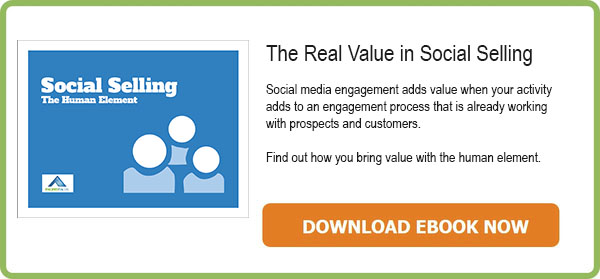
Is there real value in social selling activity for sellers, or is it all talk?
Social selling has value when your activity adds to an engagement process that is already working with prospects and customers. Social media channels broaden and vary our interaction with customers. But social media are tools, and success or failure depends on how well they are used. Adding social tools into a broken engagement process with prospects and clients is a recipe for continued disaster.
The value that sellers bring to their use of social media channels is the human element.
The Buyer’s Timeframe is What Matters
Sellers can develop long term relationships with clients on social media. But that doesn’t mean it will be easier to “bring in the deal” when the time comes – such as end of the quarter.
Understanding the whole buyer’s journey, and how social media fits, is key to being able to synch your pipeline with you buyer’s timeline.
Do Your Homework First
Before you engage, research your buyer. Look for press releases, changes in management, expansion and growth, or downsizing. Any of these may signal a business issue that you may be able to address or solve. Look at what you find to add value to your interaction with your prospect when you engage with them on social media. Added value is what your prospect is looking for in interactions with you.
Determine the Prospect’s Favorite Way to Communicate, and Use It
How often do you visit a vendor’s website, and come face-to-face with a slew of social media buttons, but no phone number? I recently had the experience of looking in vain on a website for a way to talk with a company representative about some questions. Not even a Google search produced a phone number. This was so frustrating, I decided to go elsewhere. Unless you are sure that you really know your target buyer’s communication channels, I suggest you offer all reasonable channels of communication.
Give Prospects What They Need to Make a Decision
Buyers look for different information at different stages of their journey. As they advance, they may want pricing information, a proposal, demonstrations, implementation plan, customer references, and so forth. The buyer may also want to learn if your company is a thought leader by looking at its publications and public appearances: e-books, best practice guides, infographics, white papers, trade shows, conferences, and user groups.
Is your content client focused, and responsive to their journey? Give the potential buyer what they need in order to choose you. Help prospects help themselves to this information as you see the need arise through your interactions.
What happens when you take the time to invest in your social selling activity? If you’re giving consideration to prospects to help them make decisions they feel good about, you have the basis for a mutually beneficial, strong buyer-seller relationship. Results matter. You can have all the activity in the world, but if you are not delivering results and meeting your goals, then you need to revisit your activity.
To help you identify how to build a strong buyer-seller relationship, with a role for social selling, see our free guide, Social Selling: The Human Element.
This article is just a sample of the full content — get instant access to this free ebook in our Resources section.


